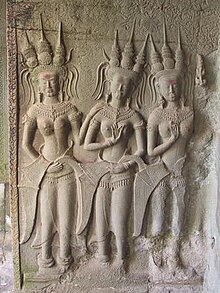| Revision as of 18:38, 26 May 2006 editRandomCritic (talk | contribs)Autopatrolled, Extended confirmed users, Pending changes reviewers27,626 editsm moved Apsara to Apsaras: Apsaras is the normally quoted stem form of the name← Previous edit | Revision as of 18:45, 26 May 2006 edit undoRandomCritic (talk | contribs)Autopatrolled, Extended confirmed users, Pending changes reviewers27,626 edits fix according to Sanskrit grammarNext edit → | ||
| Line 5: | Line 5: | ||
| <!-- Image with unknown copyright status removed: ], New York City. Note the ] that make her a prototypical beauty.]] --> | <!-- Image with unknown copyright status removed: ], New York City. Note the ] that make her a prototypical beauty.]] --> | ||
| ] | ] | ||
| '''Apsaras''' (]: |
An '''Apsaras''' (]: '''{{IAST|apsarāḥ''}}''', plural '''{{IAST|apsarasaḥ}}''', a feminine consonant stem) or '''Accharā''' (]), is a female spirit of the clouds and waters in ] and ] ]. The English plural is "apsarases". | ||
| In the ] there is one |
In the ] there is one Apsaras, wife of Gandharva; in the later scriptures there are many apsarases, created by Lord ], who act as the handmaidens of ] or the celestial damsels of his court who dance before his throne. | ||
| ] lists the following |
] lists the following apsarases: Manjukesi, Sukesi, Misrakesi, Sulochana, Saudamini, Devadatta, Devasena, Manorama, Sudati, Sundari, Vigagdha, Vividha, Budha, Sumala, Santati, Sunanda, Sumukhi, Magadhi, Arjuni, Sarala, Kerala, Dhrti, Nanda, Supuskala, Supuspamala and Kalabha. | ||
| ] | ] | ||
| Apsarases are said to be able to ], and specially rule over the ] of gaming and ]. ], ], ] and ] are the most famous among Apsarases who are well versed in the arts of ] and ]. The total number of Apsarases at Indra's court is 26, each representing a distinct aspect of the performing arts. They can be compared with the ] ]. | |||
| They may also, in their "Nature" capacity, be rendered comparable to the Greek nymphs, dryads, naiads, etc. | They may also, in their "Nature" capacity, be rendered comparable to the Greek nymphs, dryads, naiads, etc. | ||
| Apsarases are the wives of the ]s, court servants of ]. They ]d to the ] made by their husbands, usually in the various ]' ]s. | |||
| One of their duties is to guide to paradise the heroes who fall in battle, whose wives they then become. They are distinguished as ''daivika'' ("divine") or ''laukika'' ("worldly"). | One of their duties is to guide to paradise the heroes who fall in battle, whose wives they then become. They are distinguished as ''daivika'' ("divine") or ''laukika'' ("worldly"). | ||
| The |
The Apsaras was associated with ]s. In ], the lower '''Apsarases''' (also ''']s''', ]) are sometimes referred to as ]s, who sometimes lured men to their deaths. | ||
| Apsarases are often depicted in ] ] as far afield as ] and ], however. They are a common motif in the decorations of the ] temples. | |||
| {{-}} | {{-}} | ||
| == References == | == References == | ||
Revision as of 18:45, 26 May 2006
| It has been suggested that this article be merged with Tennin. (Discuss) |
- For other uses, see Apsara (disambiguation).

An Apsaras (Sanskrit: apsarāḥ, plural apsarasaḥ, a feminine consonant stem) or Accharā (Pāli), is a female spirit of the clouds and waters in Hindu and Buddhist mythology. The English plural is "apsarases".
In the Rig-Veda there is one Apsaras, wife of Gandharva; in the later scriptures there are many apsarases, created by Lord Brahma, who act as the handmaidens of Indra or the celestial damsels of his court who dance before his throne.
Natya Shatra lists the following apsarases: Manjukesi, Sukesi, Misrakesi, Sulochana, Saudamini, Devadatta, Devasena, Manorama, Sudati, Sundari, Vigagdha, Vividha, Budha, Sumala, Santati, Sunanda, Sumukhi, Magadhi, Arjuni, Sarala, Kerala, Dhrti, Nanda, Supuskala, Supuspamala and Kalabha.

Apsarases are said to be able to change their shapes at will, and specially rule over the fortunes of gaming and gambling. Urvasi, Menaka, Rambha and Tilottama are the most famous among Apsarases who are well versed in the arts of music and dancing. The total number of Apsarases at Indra's court is 26, each representing a distinct aspect of the performing arts. They can be compared with the ancient Greek muse. They may also, in their "Nature" capacity, be rendered comparable to the Greek nymphs, dryads, naiads, etc.
Apsarases are the wives of the Gandharvas, court servants of Indra. They danced to the music made by their husbands, usually in the various gods' palaces.
One of their duties is to guide to paradise the heroes who fall in battle, whose wives they then become. They are distinguished as daivika ("divine") or laukika ("worldly").
The Apsaras was associated with fertility rites. In Hinduism, the lower Apsarases (also Vrikshakas, fairies) are sometimes referred to as nature spirits, who sometimes lured men to their deaths.
Apsarases are often depicted in Buddhist art as far afield as Cambodia and China, however. They are a common motif in the decorations of the Angkor temples.
References
 This article incorporates text from a publication now in the public domain: Chisholm, Hugh, ed. (1911). Encyclopædia Britannica (11th ed.). Cambridge University Press.
This article incorporates text from a publication now in the public domain: Chisholm, Hugh, ed. (1911). Encyclopædia Britannica (11th ed.). Cambridge University Press. {{cite encyclopedia}}: Missing or empty|title=(help)
| Hindu deities and texts | ||
|---|---|---|
| Gods |  | |
| Goddesses | ||
| Other deities | ||
| Texts (list) | ||